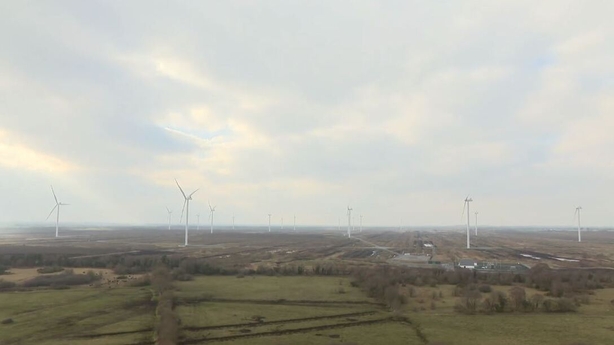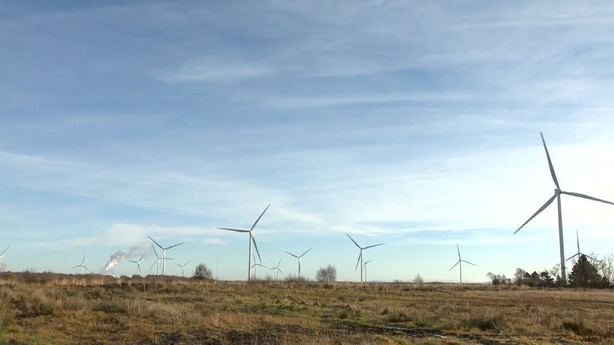Public support for wind farms has increased to a record level of 80%, according to a new survey for Wind Energy Ireland.
It said 45% of people cited cheaper electricity as the number one benefit.
If any site in the country could epitomise the energy transformation currently under way in the electricity sector, then it is the Edenderry Power Plant in Co Offaly, which is being encroached by the massive wind turbines sprouting up all around it.
The power plant still burns peat, mixed with biomass, to generate electricity.
So, it spews out a constant stream of climate changing greenhouse gas emissions, pushing tonnes of carbon dioxide into the skies above ever day.
But from the rooftop of the power plant, nine storeys high, 49 huge wind turbines are visible.

They stretch westward from the entrance to the power plant through Bord na Móna's adjoining Clonkreen and Mount Lucas bogs.
Between them, on the windiest days, these 49 wind turbines could potentially produce 60% more electricity than the power plant, while releasing absolutely no greenhouse gases at all.
These days almost 40% of annual electricity in Ireland is supplied from renewables with wind being the dominant source.
In fact, last year, on some of the days when wind was at its strongest, up to 80% of Ireland's electricity came from wind.
Ireland spending €1m 'every hour on imported fossil fuels'
Bord na Móna now labels the power plant and its adjoining wind farms as "The Edenderry Clean Power Complex" capable of supplying enough electricity to power a quarter of a million homes from just one corner of north Offaly.
John Reilly, Head of Power at Bord na Móna, said ten years ago the Edenderry Power Station on its own was burning almost one million tonnes of peat annually and was producing about a million tonnes of CO2.
By the end of this year, when turf burning ends and the plant switches to 100% biomass, the entire complex will be supplying far more electricity with no greenhouse emissions at all.
The other big positive he said was that this is Ireland's own energy, it is not imported from abroad.
"Ireland is spending €1 million every hour on imported fossil fuels," he said.
"The solution to that problem and the affordability challenges it creates is to harvest more and more onshore wind, something that Ireland has become very, very good at."
Mr Reilly said wind farm developers have become far better at engaging properly with communities where they want to erect turbines and this has helped to reduce public opposition to new developments.
The Mount Lucas and Clonkreen wind farms for instance are open to the public to allow people to walk and cycle around them.

As a result people have become gradually more familiar with the technology and this has also helped make it more acceptable.
The results of today's public attitudes survey conducted by Interactions Research for Wind Energy Ireland seems to bear this out.
It found support for wind energy to be as high as 80% nationally, and 85% in rural areas and that 58% of people would support the development of a wind farm in their own local area.
However, according to the survey, in the minds of the Irish public these days, low emissions clean energy is not the number one benefit they think about when they think about wind farms.
Instead, it is the fact that wind farms help to make our electricity cheaper.
That was cited by 45% of people as the number one benefit compared with just 22% who cited lower greenhouse gas emissions as their number one benefit from wind farms.
Mr Reilly believes the situation in Ukraine has played a part in all that.
He said the terrible impact the Russian war has had on energy prices has shown that people should never take energy security for granted.
He believes that has helped in the public understanding about why Ireland needs this infrastructure.







